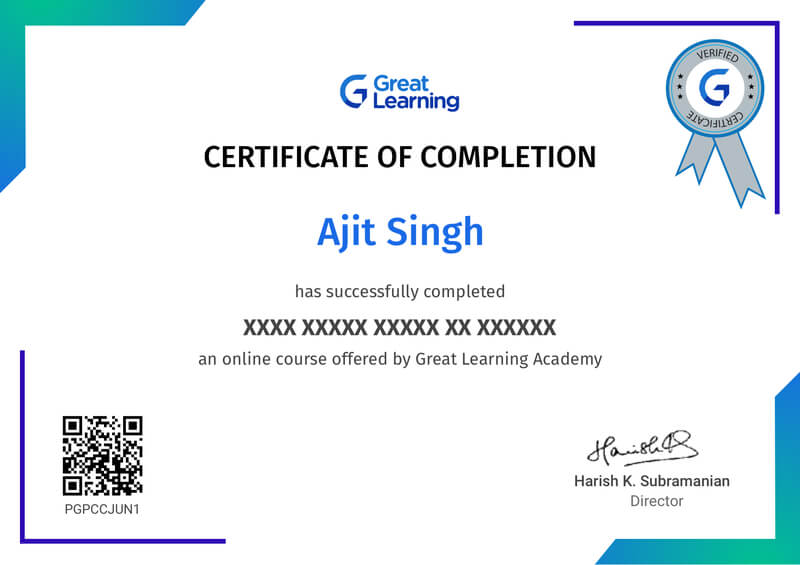Start Learning Now!

Verified Certificate

Self Paced Projects

5+ Assignments & Quizzes

Discussion Support
Course Description
Data Scientist
DXC Technology
Consultant Analyst
Kantar
Data Scientist
Genpact
Learn practical skills by working on real-world projects. As part of this course, you will be working on the below mentioned projects
Earn a Verified Certificate from Great Learning Academy, which is highly regarded and valued by corporates. Make your CV & LinkedIn profile stand out from the rest.
Module 1
Module 2
Module 3
Module 4
Module 5
Module 6
You can access all these courses for 1 year.
It is a 100% online learning course that you can learn at your own pace through our website and mobile app.
The certificates are rolled out as and when you complete the mandatory course content and submit the project with a satisfactory grade.
Yes. You will gain complete access to our Discussion forum support in your course to connect with our SMEs to resolve your course content related queries within 48 hrs.
Fees once paid is not refundable. Kindly make an informed decision before enrolling into the course.
Python is an object-oriented high-level programming language which is currently the most preferred programming language by professionals as well as organisations. Most of the beginners prefer python as their first programming language as it is simple and versatile. One can use Python for data analysis, web development, Internet of Things and many other areas of business and technology. Python is also well-supported by the community and keeps up with its popularity with new developments.
Python has become the most preferred language for enabling data science and machine learning applications. It has a lot of advantages over other languages as it is swift and the syntax is easy too. As it is a java-based programming language, one can extend its applications in the field of data science beyond analytical and statistical modelling. It will also simplify developing web applications and integrate them directly with the analytical models in the background.
Another advantage of using Python is that one can easily integrate with other platforms and programming languages. Programmers find it extremely easy to transition to the analytics and data science domains as Python has a common object-oriented programming architecture. It also has excellent documentation support.
Here are seven reasons why Python should be your top choice among programming languages:
Mastering Python will involve learning the basics, an understanding of Python libraries and their functionalities, and practice. Here are the must-have skills for a programmer to become an expert in Python.
If you wish to learn Python for data science, then it is very important to have a knowledge of Python libraries that are used in data science applications. Some of the commonly used libraries for data science are:
Other libraries that are popular in Data Science domain are:
Python’s popularity mainly comes from the ease of learning the language. It is simple and type-free and therefore it is easy to learn. Many people ask how much time does it take to learn Python? The answer is that the time taken to learn the language will depend on the level of expertise you want to achieve with the language. Also, depending on individual ability, the learning curve could be shorter or longer. Overall, learning Python is not too difficult and absolutely doable even if one is not from a technical background.
The highly sophisticated skills important for data science include concepts of data analytics, experience with required libraries, image processing and more. Let us see how one should proceed with learning Python.
Start with the basics of Python, such as syntax, keywords, functions, classes, data-types, basic coding and exception handling. Then depending on the nature of your work, you can learn specific skills such as synchronisation techniques, database programming, multithreading etc.
Higher-level skills in Python include data analytics, image processing, hands-on experience of various libraries such as Numpy and Pandas, and more. To master these skills, it will take implementation, experimenting, and practice.
A data scientist should possess knowledge about data analysis, data interpretation, and data manipulation with Python. Mathematics and statistics are also very beneficial for making the right decisions. Adequate knowledge of Python libraries like Tensorflow, Scikit learn and others mentioned above is also crucial for successfully fulfilling the role of a data scientist. Some of the machine learning algorithms such as Naive Bayes, regression analysis, etc. are essential as well.
Sign up for this program to learn Python for Data Science. The course curriculum covers all the important topics within 15 hours of quality content delivered by top faculty Dr Abhinanda Sarkar, Mr R Vivekanada, and Prof Mukesh Rao.
This program is also useful if you want to learn Python for Data Analysis along with mastering Python for Data Science. If you have read Python for data science for dummies, this course will seem more relevant and a step ahead to it. With a detailed intro to Python for Data Science, the course covers all python basics and is suitable for professionals from a non-coding background.
The course curriculum is conducive to learning and covers a wide range of topics starting from the basics. You will learn modules such as Numpy, Pandas, and Matplotlib. Exploratory data analysis concepts such as Data Cleaning, Data Preprocessing, and Feature Engineering are also covered. Further, you get to learn how to apply Python in Supervised and Unsupervised learning. Lastly, you get to learn data visualization with Tableau for data representation and analysis using plots, charts, and other visual elements.
With the assignments and practice tests that come along with the course, you can ensure that you practice what you learn and master the concepts. You will also get a direction on how to apply your learnings practically into your job.
